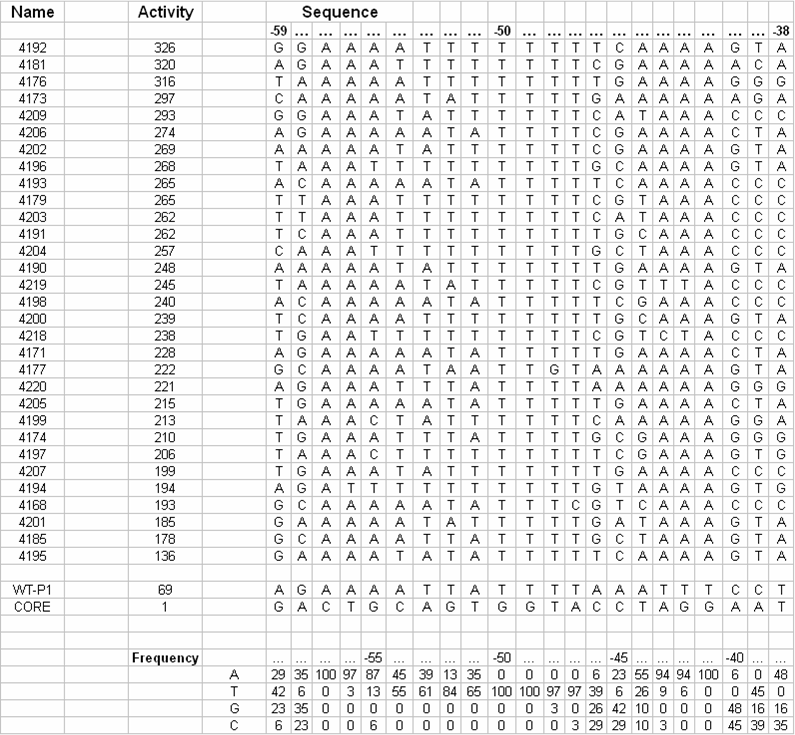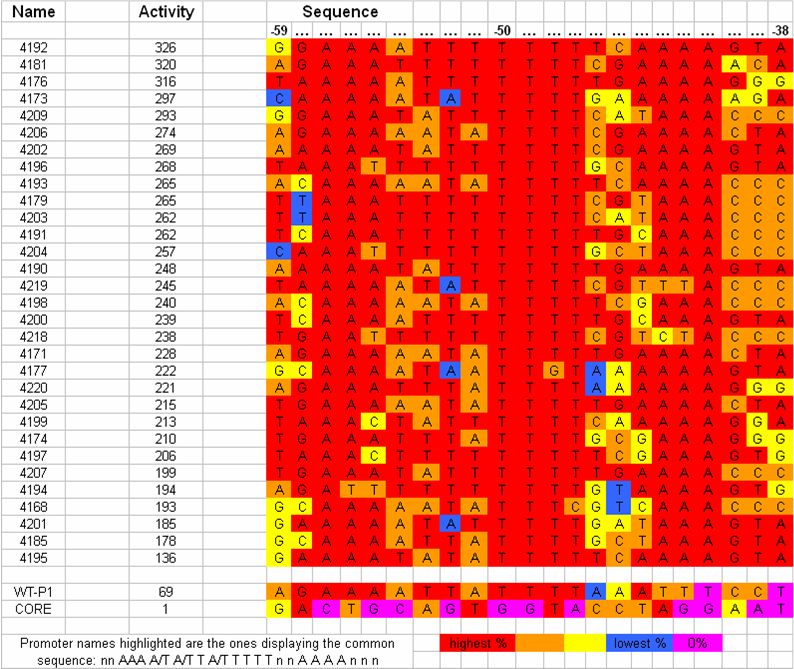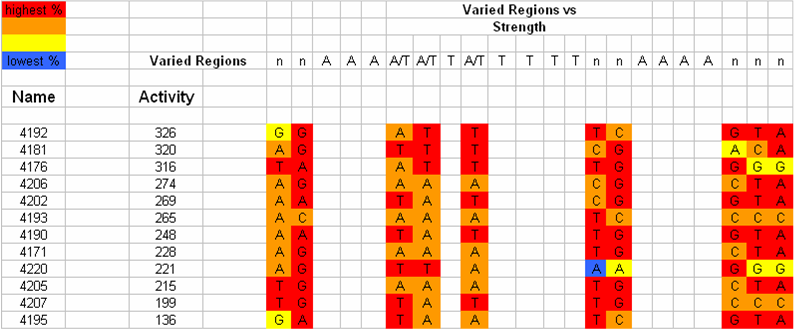Team:Virginia Commonwealth/Design
From 2009.igem.org
GMcArthurIV (Talk | contribs) (→UP-element design) |
GMcArthurIV (Talk | contribs) (→Future work) |
||
| (17 intermediate revisions not shown) | |||
| Line 5: | Line 5: | ||
| | | | ||
==UP-element design== | ==UP-element design== | ||
| - | UP-elements are known to significantly increase the RNA polymerase-recruiting power of promoters by interacting with the alpha subunit of RNA polymerase. Work has been done to identify a consensus sequence for this transcriptional enhancer based on 31 natural ''E. coli'' promoters (Estrem ST, Gaal T, Ross W, Gourse RL, Identification of an UP element consensus sequence for bacterial promoters, ''PNAS'', (1998), 95, 9761-9766.). | + | UP-elements are known to significantly increase the RNA polymerase-recruiting power of promoters by interacting with the alpha subunit of RNA polymerase. Work has been done to identify a consensus sequence for this transcriptional enhancer based on 31 natural ''E. coli'' promoters (Estrem ST, Gaal T, Ross W, Gourse RL, Identification of an UP element consensus sequence for bacterial promoters, ''PNAS'', (1998), 95, 9761-9766 [http://www.ncbi.nlm.nih.gov/pubmed/9707549 PubMed]). |
| - | [[Image:VCU 2009 tabulated UP-elements.png|thumb|center|400px|Figure 1: Tabulation of UP-elements in ''E. coli'' and nucleotide frequency at each position (adapted from Estrem ST, Gaal T, Ross W, Gourse RL, Identification of an UP element consensus sequence for bacterial promoters, ''PNAS'', (1998), 95, 9761-9766.)]] | + | [[Image:VCU 2009 tabulated UP-elements.png|thumb|center|400px|Figure 1: Tabulation of UP-elements in ''E. coli'' and nucleotide frequency at each position (adapted from Estrem ST, Gaal T, Ross W, Gourse RL, Identification of an UP element consensus sequence for bacterial promoters, ''PNAS'', (1998), 95, 9761-9766 [http://www.ncbi.nlm.nih.gov/pubmed/9707549 PubMed])]] |
| - | We | + | We have designed novel UP-element sequences as modular BioBrick parts by modifying a naturally-occurring UP element. The primary design goal in developing these new parts was to vary the strength of transcription initiation enhancement by rationally modifying the nucleotide sequence of the variable regions (i.e., non consensus regions). This approach was guided by the hypothesis that natural sequences resulting in stronger promoter enhancement have been selected for over evolutionary time by ''E. coli'' and therefore occur more frequently than weaker UP-elements. |
[[Image:VCU 2009 UP-element tabulated nucleotide frequency.png|thumb|center|650px|Tabulation of UP-element sequences in order of observed strengths and correlation with nucleotide frequency]] | [[Image:VCU 2009 UP-element tabulated nucleotide frequency.png|thumb|center|650px|Tabulation of UP-element sequences in order of observed strengths and correlation with nucleotide frequency]] | ||
| + | |||
| + | Data showed direct correlation between the strength of naturally occurring UP-elements and the frequency of each nucleotide at each respective position. Thirty one UP-element sequences were analyzed for nucleotide frequency and the relative activity was tabulated for each sequence (Estrem, ''et. al''). From this a consensus UP-element sequence was identified which was composed of the most frequently occurring nucleotide at each position. | ||
| + | |||
| + | |||
[[Image:VCU 2009 UP-element variable regions.png|thumb|center|650px|UP-element consensus sequence and observed variable regions for selected sequences (that most closely matched the consensus sequence)]] | [[Image:VCU 2009 UP-element variable regions.png|thumb|center|650px|UP-element consensus sequence and observed variable regions for selected sequences (that most closely matched the consensus sequence)]] | ||
| + | |||
| + | We separated the UP-element sequence into regions of highly conserved and highly variable nucleotide frequency. We hypothesized that variation of strength of the UP-element is attributed to the variable regions within the sequence. Upon further analysis of the nucleotide frequency in the variable regions we determined that changing a single base to the second most frequent nucleotide would allow us to quantify the relationship between nucleotide frequency and UP-element strength. | ||
| + | |||
[[Image:VCU 2009 UP-element design sequences.png|thumb|center|930px|Sequences of designed UP-elements]] | [[Image:VCU 2009 UP-element design sequences.png|thumb|center|930px|Sequences of designed UP-elements]] | ||
| - | + | ||
| - | + | These UP-element designs were directly synthesized to include a well-characterized constitutive promoter and BioBrick ends on either end of the UP-element promoter sequence. We also synthesized an UP-element as a modular BioBrick part to study the effect of the added nucleotide spacing between the UP-element and the promoter due to the BioBrick assembly scar. It is likely that the additional spacing of the eight base pair BioBrick assembly scar may have a significant effect on part performance. | |
==Future work== | ==Future work== | ||
| - | * | + | *Higher understanding |
| - | ** | + | **From our results, we would potentially be able to more accurately predict the transcriptional effect of the UP-element with each nucleotide change. From this, we would like to create and characterize more UP-elements and possibly come to a more precise consensus sequence. |
| - | ** | + | **It has been suggested that both alpha subunits located in the RNAP bind to the UP-element at once. We would like to test this theory by measuring the binding strength when both alpha subunits are present and when only one is present. |
| + | |||
| + | <br /> | ||
| + | *Regulated promoters | ||
| + | **We would like to study operator sites and redesign them as biobrick parts to tighten the control at the transcriptional level. | ||
| + | |||
<br /> | <br /> | ||
*T7 Promoters | *T7 Promoters | ||
Latest revision as of 03:48, 22 October 2009
UP-element designUP-elements are known to significantly increase the RNA polymerase-recruiting power of promoters by interacting with the alpha subunit of RNA polymerase. Work has been done to identify a consensus sequence for this transcriptional enhancer based on 31 natural E. coli promoters (Estrem ST, Gaal T, Ross W, Gourse RL, Identification of an UP element consensus sequence for bacterial promoters, PNAS, (1998), 95, 9761-9766 [http://www.ncbi.nlm.nih.gov/pubmed/9707549 PubMed]).
We have designed novel UP-element sequences as modular BioBrick parts by modifying a naturally-occurring UP element. The primary design goal in developing these new parts was to vary the strength of transcription initiation enhancement by rationally modifying the nucleotide sequence of the variable regions (i.e., non consensus regions). This approach was guided by the hypothesis that natural sequences resulting in stronger promoter enhancement have been selected for over evolutionary time by E. coli and therefore occur more frequently than weaker UP-elements. Data showed direct correlation between the strength of naturally occurring UP-elements and the frequency of each nucleotide at each respective position. Thirty one UP-element sequences were analyzed for nucleotide frequency and the relative activity was tabulated for each sequence (Estrem, et. al). From this a consensus UP-element sequence was identified which was composed of the most frequently occurring nucleotide at each position.
We separated the UP-element sequence into regions of highly conserved and highly variable nucleotide frequency. We hypothesized that variation of strength of the UP-element is attributed to the variable regions within the sequence. Upon further analysis of the nucleotide frequency in the variable regions we determined that changing a single base to the second most frequent nucleotide would allow us to quantify the relationship between nucleotide frequency and UP-element strength. These UP-element designs were directly synthesized to include a well-characterized constitutive promoter and BioBrick ends on either end of the UP-element promoter sequence. We also synthesized an UP-element as a modular BioBrick part to study the effect of the added nucleotide spacing between the UP-element and the promoter due to the BioBrick assembly scar. It is likely that the additional spacing of the eight base pair BioBrick assembly scar may have a significant effect on part performance. Future work
| |
 "
"




